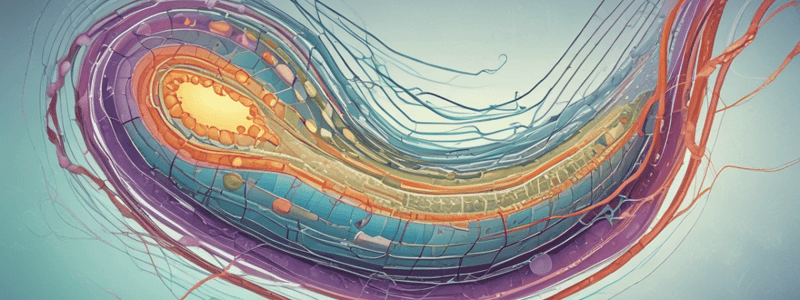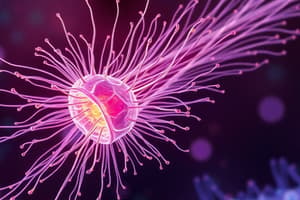Podcast
Questions and Answers
Where is the DNA located in a prokaryotic cell?
Where is the DNA located in a prokaryotic cell?
- In paired chromosomes
- Wrapped around histones
- In a membrane-bound nucleus
- In the cytoplasm (correct)
What is the function of inclusions in prokaryotic cells?
What is the function of inclusions in prokaryotic cells?
- DNA replication
- Energy production
- Storage of nutrients or metabolic end products (correct)
- Cell division
Under what conditions do prokaryotic cells form endospores?
Under what conditions do prokaryotic cells form endospores?
- When nutrients are abundant
- During cell division
- During favorable growth conditions
- Under high stress or adverse conditions (correct)
How do prokaryotic flagella differ from eukaryotic flagella?
How do prokaryotic flagella differ from eukaryotic flagella?
What is the main structural difference between prokaryotic and eukaryotic cell flagella?
What is the main structural difference between prokaryotic and eukaryotic cell flagella?
What is the primary function of flagella in cells?
What is the primary function of flagella in cells?
What is the primary function of flagella in bacteria?
What is the primary function of flagella in bacteria?
Which component of flagella distinguishes among different serovars of bacteria?
Which component of flagella distinguishes among different serovars of bacteria?
What is the primary difference between flagella and axial filaments in bacterial motility?
What is the primary difference between flagella and axial filaments in bacterial motility?
Which cellular appendage allows for attachment in bacterial cells?
Which cellular appendage allows for attachment in bacterial cells?
What is the structural composition of archaella, the motility structure in archaea?
What is the structural composition of archaella, the motility structure in archaea?
Which prokaryotic structure is involved in long-term survival under adverse conditions?
Which prokaryotic structure is involved in long-term survival under adverse conditions?
What is the function of flagella and cilia in cells?
What is the function of flagella and cilia in cells?
How are flagella and cilia different in terms of length?
How are flagella and cilia different in terms of length?
What is the main component of eukaryotic flagella and cilia?
What is the main component of eukaryotic flagella and cilia?
How are microtubules organized in eukaryotic flagella and cilia?
How are microtubules organized in eukaryotic flagella and cilia?
What is the key difference between the structure of prokaryotic and eukaryotic flagella?
What is the key difference between the structure of prokaryotic and eukaryotic flagella?
What allows flagella to move in a wavelike manner?
What allows flagella to move in a wavelike manner?
What is the function of inclusions in prokaryotic cells?
What is the function of inclusions in prokaryotic cells?
Where is the DNA located in a prokaryotic cell?
Where is the DNA located in a prokaryotic cell?
Under what conditions do prokaryotic cells form endospores?
Under what conditions do prokaryotic cells form endospores?
How are prokaryotic and eukaryotic flagella different?
How are prokaryotic and eukaryotic flagella different?
What is the primary function of flagella in cells?
What is the primary function of flagella in cells?
Which component of flagella distinguishes among different serovars of bacteria?
Which component of flagella distinguishes among different serovars of bacteria?
What is a key structural difference between prokaryotic and eukaryotic flagella?
What is a key structural difference between prokaryotic and eukaryotic flagella?
What is the primary function of inclusions in cells?
What is the primary function of inclusions in cells?
Under what conditions do prokaryotic cells form endospores?
Under what conditions do prokaryotic cells form endospores?
What is the main structural component of flagella in cells?
What is the main structural component of flagella in cells?
How do prokaryotic and eukaryotic flagella differ in terms of length and number?
How do prokaryotic and eukaryotic flagella differ in terms of length and number?
What is the primary function of flagella in cells?
What is the primary function of flagella in cells?
Where is the DNA typically located in a prokaryotic cell?
Where is the DNA typically located in a prokaryotic cell?
Which of the following is a function of inclusions in prokaryotic cells?
Which of the following is a function of inclusions in prokaryotic cells?
Under what conditions do prokaryotic cells form endospores?
Under what conditions do prokaryotic cells form endospores?
How does the structure of prokaryotic flagella differ from eukaryotic flagella?
How does the structure of prokaryotic flagella differ from eukaryotic flagella?
What is one of the main functions of flagella in cells?
What is one of the main functions of flagella in cells?
How do prokaryotic and eukaryotic flagella differ in terms of their attachment to the cell?
How do prokaryotic and eukaryotic flagella differ in terms of their attachment to the cell?
Study Notes
Flagella and Cilia
- Flagella are long projections used for locomotion or moving substances along the cell surface, found in few numbers.
- Cilia are short projections used for locomotion or moving substances along the cell surface, found in numerous numbers.
- Both flagella and cilia consist of microtubules made of the protein tubulin, organized as 9 pairs in a ring, plus 2 microtubules in the center (9 + 2 array), allowing them to move in a wavelike manner.
The Cell Wall and Glycocalyx
- Cell walls are found in plants, algae, and fungi, made of carbohydrates (cellulose in plants, chitin in fungi, and glucan and mannan in yeasts).
- Glycocalyx is found in animal cells, consisting of carbohydrates bonded to proteins and lipids in the plasma membrane.
Flagella in Bacteria
- Flagella in bacteria allow them to move toward or away from stimuli (taxis).
- Flagella rotate to “run” or “tumble”, and their proteins are H antigens that distinguish among serovars (e.g., Escherichia coli O157:H7).
Archaella
- Archaella are archaeal motility structures made of glycoproteins (archaellins), anchored to the cell, and rotate like flagella.
Axial Filaments
- Axial filaments are also called endoflagella, found in spirochetes, anchored at one end of a cell, and cause the cell to move like a corkscrew when rotated.
Fimbriae and Pili
- Fimbriae are hairlike appendages that allow for attachment.
Comparing Prokaryotic and Eukaryotic Cells
- Prokaryotes have one circular chromosome, no histones, no organelles, and cell walls made of peptidoglycan (bacteria) or pseudomurein (archaea), and divide by binary fission.
- Eukaryotes have paired chromosomes in a nuclear membrane, histones, organelles, and cell walls made of polysaccharides when present, and divide by mitosis.
Prokaryotic Cells
- Prokaryotic cells have three basic shapes: bacilli (rod-shaped), cocci (spherical), and spirilla (spiral-shaped).
Studying That Suits You
Use AI to generate personalized quizzes and flashcards to suit your learning preferences.
Related Documents
Description
Test your knowledge on flagella and cilia projections used for locomotion and moving substances along the cell surface. Learn about the differences between flagella and cilia, their structures, and functions.




